Qantas Airways' Strategic Market Entry and Expansion in India
VerifiedAdded on 2021/06/18
|7
|1353
|159
Report
AI Summary
This report examines the potential expansion of Qantas Airways into the Indian market. It begins with an introduction highlighting the importance of internationalization and market understanding. The report then delves into a PEST analysis, assessing the political, economic, social, technological, and legal factors influencing the airline industry in India. It discusses government intervention in the aviation sector and the economic integration of India. The strategic reasons for Qantas's expansion are explored, including India's growing population and increasing disposable incomes. The report recommends a joint venture as the optimal market entry strategy, considering government regulations. Finally, it suggests modifications to the marketing mix, including product, pricing, place, and promotion strategies tailored to the Indian market. The conclusion emphasizes the lucrative opportunities and growth avenues available for Qantas in India.
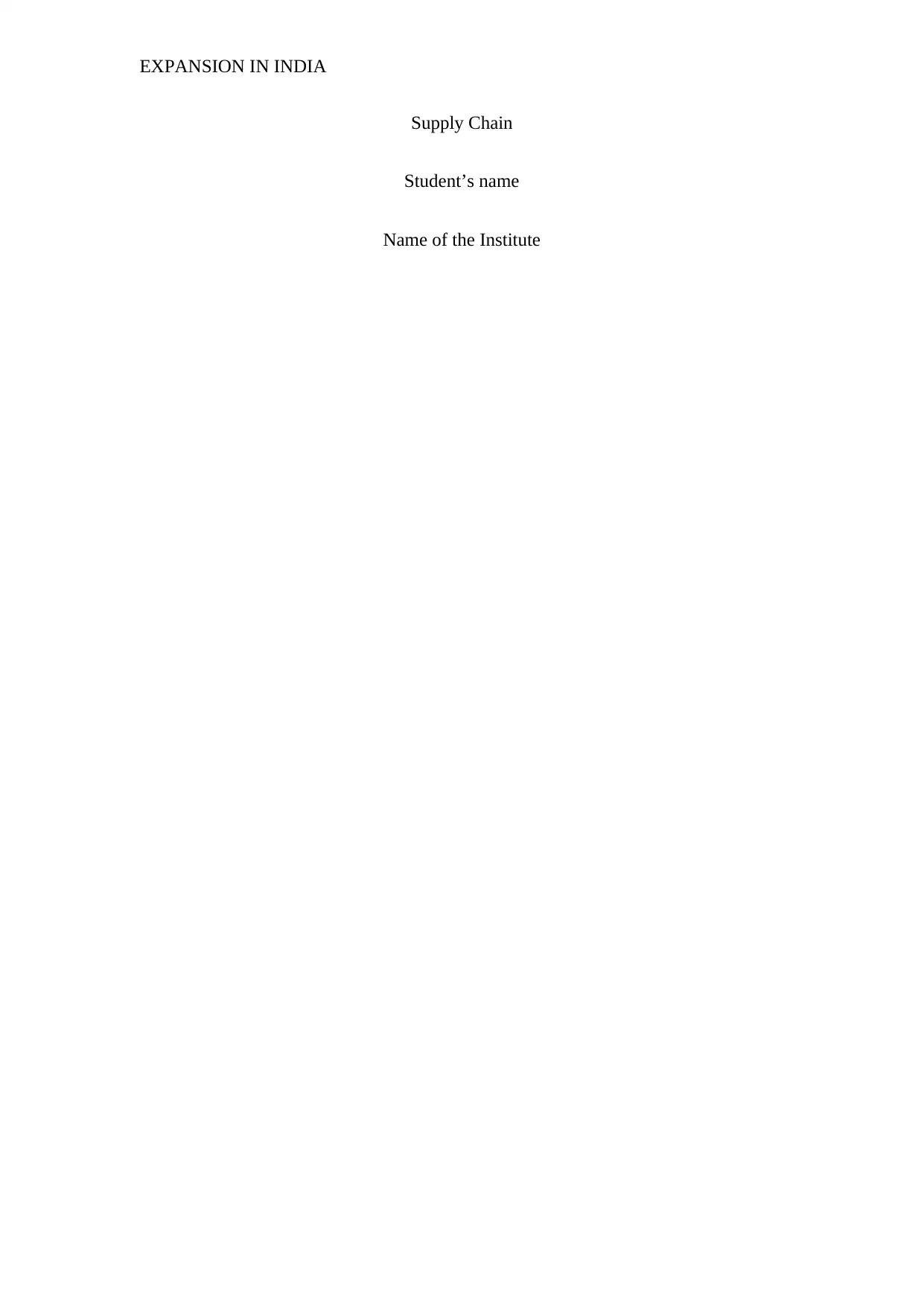
EXPANSION IN INDIA
Supply Chain
Student’s name
Name of the Institute
Supply Chain
Student’s name
Name of the Institute
Paraphrase This Document
Need a fresh take? Get an instant paraphrase of this document with our AI Paraphraser
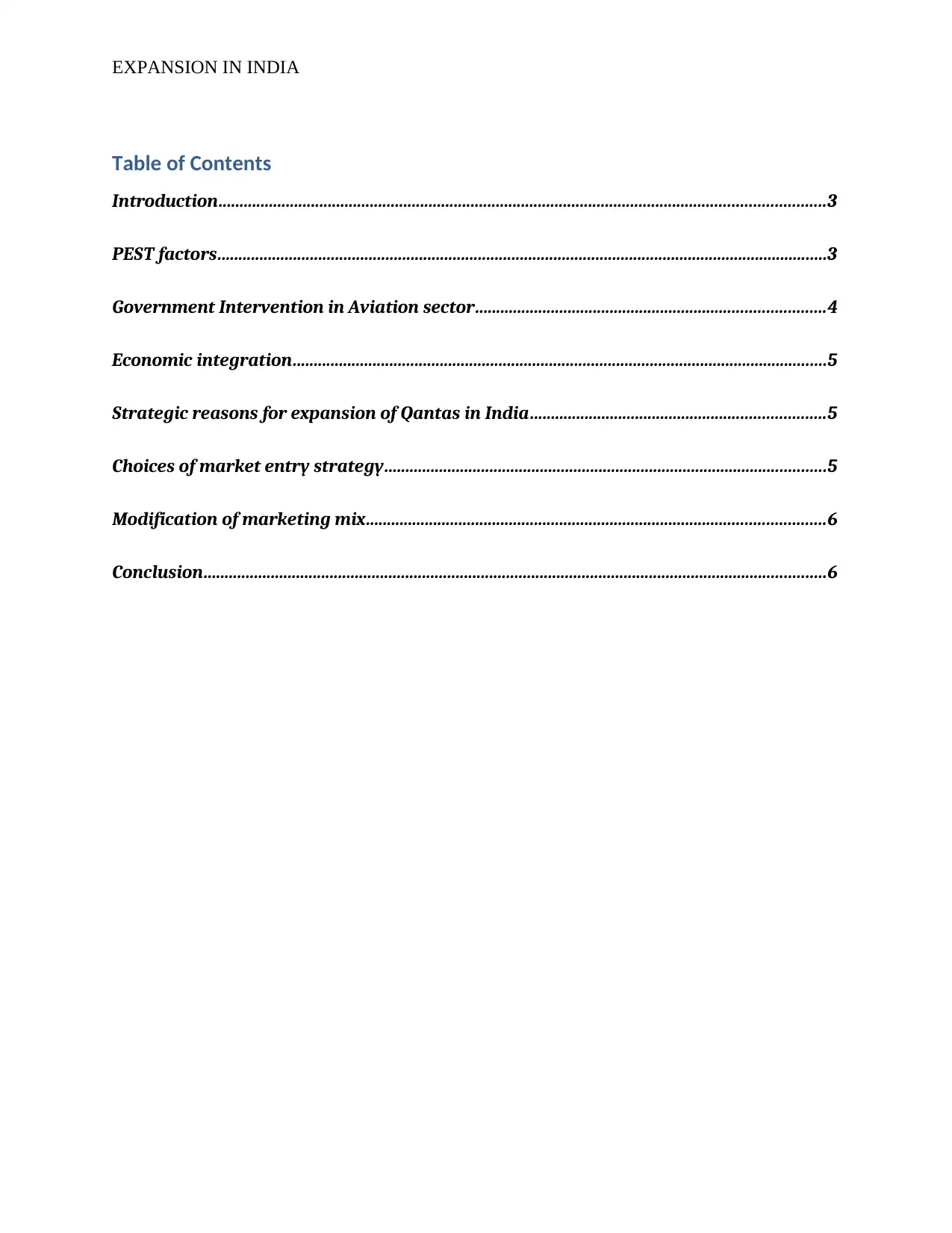
EXPANSION IN INDIA
Table of Contents
Introduction................................................................................................................................................3
PEST factors.................................................................................................................................................3
Government Intervention in Aviation sector...................................................................................4
Economic integration...............................................................................................................................5
Strategic reasons for expansion of Qantas in India......................................................................5
Choices of market entry strategy.........................................................................................................5
Modification of marketing mix.............................................................................................................6
Conclusion....................................................................................................................................................6
Table of Contents
Introduction................................................................................................................................................3
PEST factors.................................................................................................................................................3
Government Intervention in Aviation sector...................................................................................4
Economic integration...............................................................................................................................5
Strategic reasons for expansion of Qantas in India......................................................................5
Choices of market entry strategy.........................................................................................................5
Modification of marketing mix.............................................................................................................6
Conclusion....................................................................................................................................................6
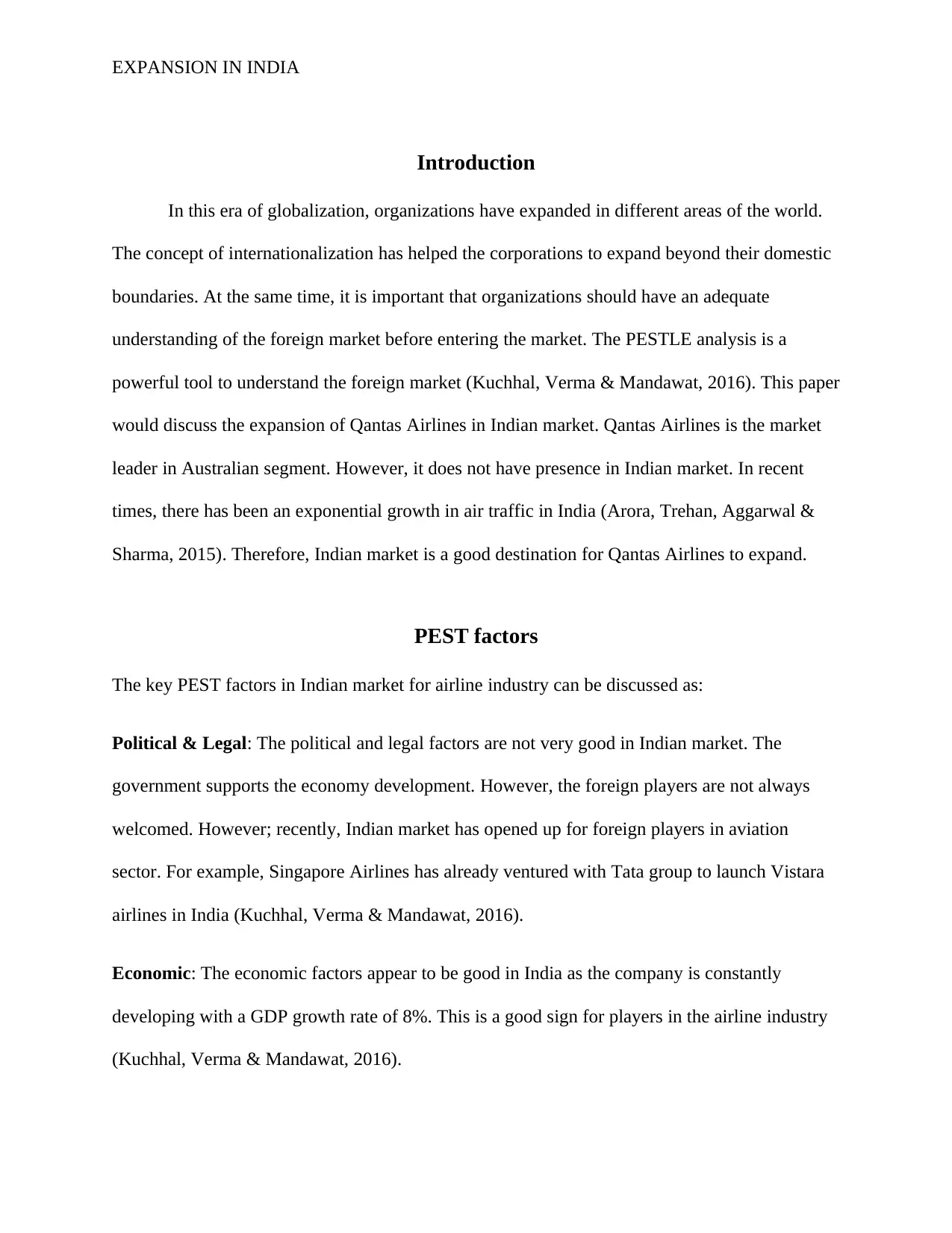
EXPANSION IN INDIA
Introduction
In this era of globalization, organizations have expanded in different areas of the world.
The concept of internationalization has helped the corporations to expand beyond their domestic
boundaries. At the same time, it is important that organizations should have an adequate
understanding of the foreign market before entering the market. The PESTLE analysis is a
powerful tool to understand the foreign market (Kuchhal, Verma & Mandawat, 2016). This paper
would discuss the expansion of Qantas Airlines in Indian market. Qantas Airlines is the market
leader in Australian segment. However, it does not have presence in Indian market. In recent
times, there has been an exponential growth in air traffic in India (Arora, Trehan, Aggarwal &
Sharma, 2015). Therefore, Indian market is a good destination for Qantas Airlines to expand.
PEST factors
The key PEST factors in Indian market for airline industry can be discussed as:
Political & Legal: The political and legal factors are not very good in Indian market. The
government supports the economy development. However, the foreign players are not always
welcomed. However; recently, Indian market has opened up for foreign players in aviation
sector. For example, Singapore Airlines has already ventured with Tata group to launch Vistara
airlines in India (Kuchhal, Verma & Mandawat, 2016).
Economic: The economic factors appear to be good in India as the company is constantly
developing with a GDP growth rate of 8%. This is a good sign for players in the airline industry
(Kuchhal, Verma & Mandawat, 2016).
Introduction
In this era of globalization, organizations have expanded in different areas of the world.
The concept of internationalization has helped the corporations to expand beyond their domestic
boundaries. At the same time, it is important that organizations should have an adequate
understanding of the foreign market before entering the market. The PESTLE analysis is a
powerful tool to understand the foreign market (Kuchhal, Verma & Mandawat, 2016). This paper
would discuss the expansion of Qantas Airlines in Indian market. Qantas Airlines is the market
leader in Australian segment. However, it does not have presence in Indian market. In recent
times, there has been an exponential growth in air traffic in India (Arora, Trehan, Aggarwal &
Sharma, 2015). Therefore, Indian market is a good destination for Qantas Airlines to expand.
PEST factors
The key PEST factors in Indian market for airline industry can be discussed as:
Political & Legal: The political and legal factors are not very good in Indian market. The
government supports the economy development. However, the foreign players are not always
welcomed. However; recently, Indian market has opened up for foreign players in aviation
sector. For example, Singapore Airlines has already ventured with Tata group to launch Vistara
airlines in India (Kuchhal, Verma & Mandawat, 2016).
Economic: The economic factors appear to be good in India as the company is constantly
developing with a GDP growth rate of 8%. This is a good sign for players in the airline industry
(Kuchhal, Verma & Mandawat, 2016).
⊘ This is a preview!⊘
Do you want full access?
Subscribe today to unlock all pages.

Trusted by 1+ million students worldwide
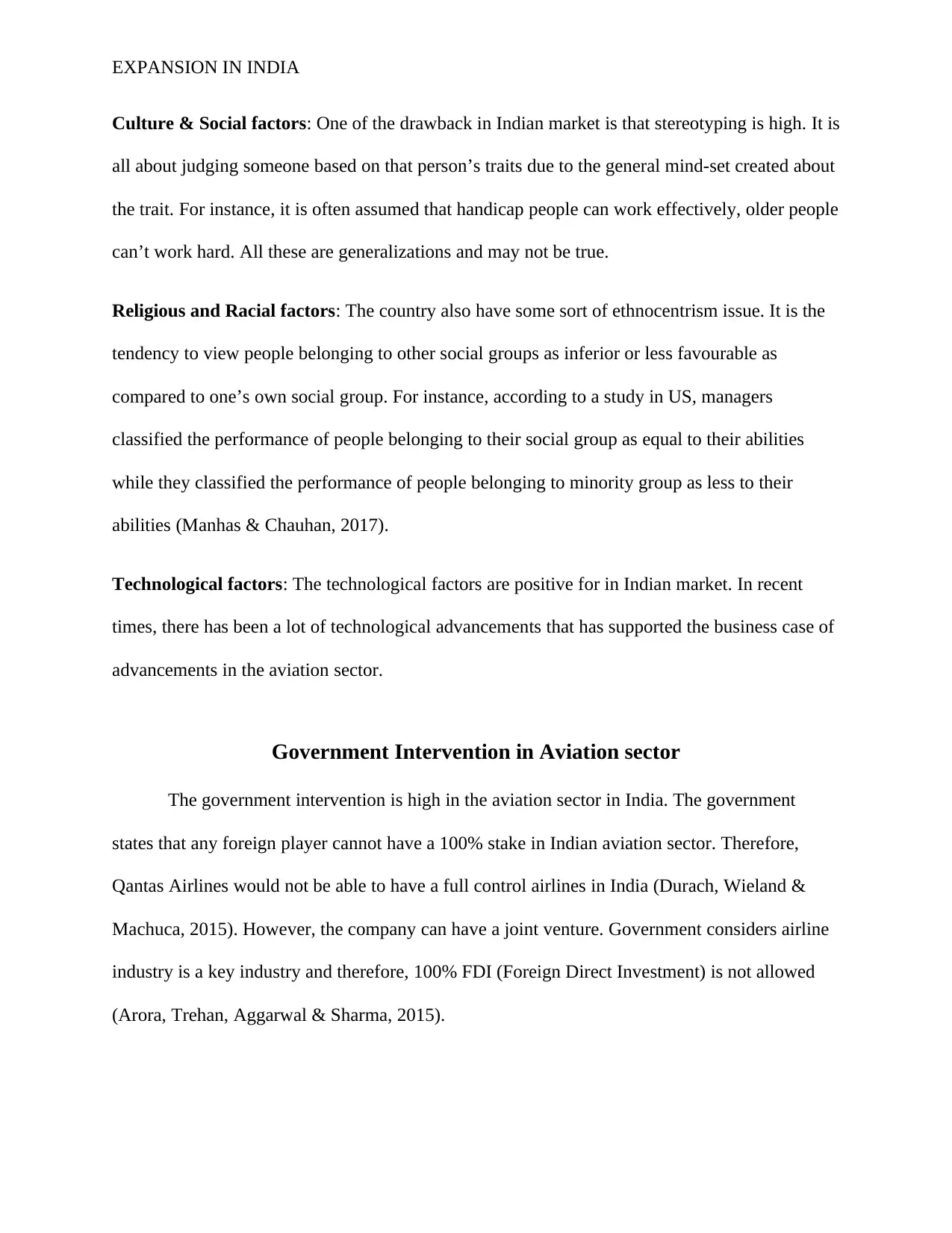
EXPANSION IN INDIA
Culture & Social factors: One of the drawback in Indian market is that stereotyping is high. It is
all about judging someone based on that person’s traits due to the general mind-set created about
the trait. For instance, it is often assumed that handicap people can work effectively, older people
can’t work hard. All these are generalizations and may not be true.
Religious and Racial factors: The country also have some sort of ethnocentrism issue. It is the
tendency to view people belonging to other social groups as inferior or less favourable as
compared to one’s own social group. For instance, according to a study in US, managers
classified the performance of people belonging to their social group as equal to their abilities
while they classified the performance of people belonging to minority group as less to their
abilities (Manhas & Chauhan, 2017).
Technological factors: The technological factors are positive for in Indian market. In recent
times, there has been a lot of technological advancements that has supported the business case of
advancements in the aviation sector.
Government Intervention in Aviation sector
The government intervention is high in the aviation sector in India. The government
states that any foreign player cannot have a 100% stake in Indian aviation sector. Therefore,
Qantas Airlines would not be able to have a full control airlines in India (Durach, Wieland &
Machuca, 2015). However, the company can have a joint venture. Government considers airline
industry is a key industry and therefore, 100% FDI (Foreign Direct Investment) is not allowed
(Arora, Trehan, Aggarwal & Sharma, 2015).
Culture & Social factors: One of the drawback in Indian market is that stereotyping is high. It is
all about judging someone based on that person’s traits due to the general mind-set created about
the trait. For instance, it is often assumed that handicap people can work effectively, older people
can’t work hard. All these are generalizations and may not be true.
Religious and Racial factors: The country also have some sort of ethnocentrism issue. It is the
tendency to view people belonging to other social groups as inferior or less favourable as
compared to one’s own social group. For instance, according to a study in US, managers
classified the performance of people belonging to their social group as equal to their abilities
while they classified the performance of people belonging to minority group as less to their
abilities (Manhas & Chauhan, 2017).
Technological factors: The technological factors are positive for in Indian market. In recent
times, there has been a lot of technological advancements that has supported the business case of
advancements in the aviation sector.
Government Intervention in Aviation sector
The government intervention is high in the aviation sector in India. The government
states that any foreign player cannot have a 100% stake in Indian aviation sector. Therefore,
Qantas Airlines would not be able to have a full control airlines in India (Durach, Wieland &
Machuca, 2015). However, the company can have a joint venture. Government considers airline
industry is a key industry and therefore, 100% FDI (Foreign Direct Investment) is not allowed
(Arora, Trehan, Aggarwal & Sharma, 2015).
Paraphrase This Document
Need a fresh take? Get an instant paraphrase of this document with our AI Paraphraser
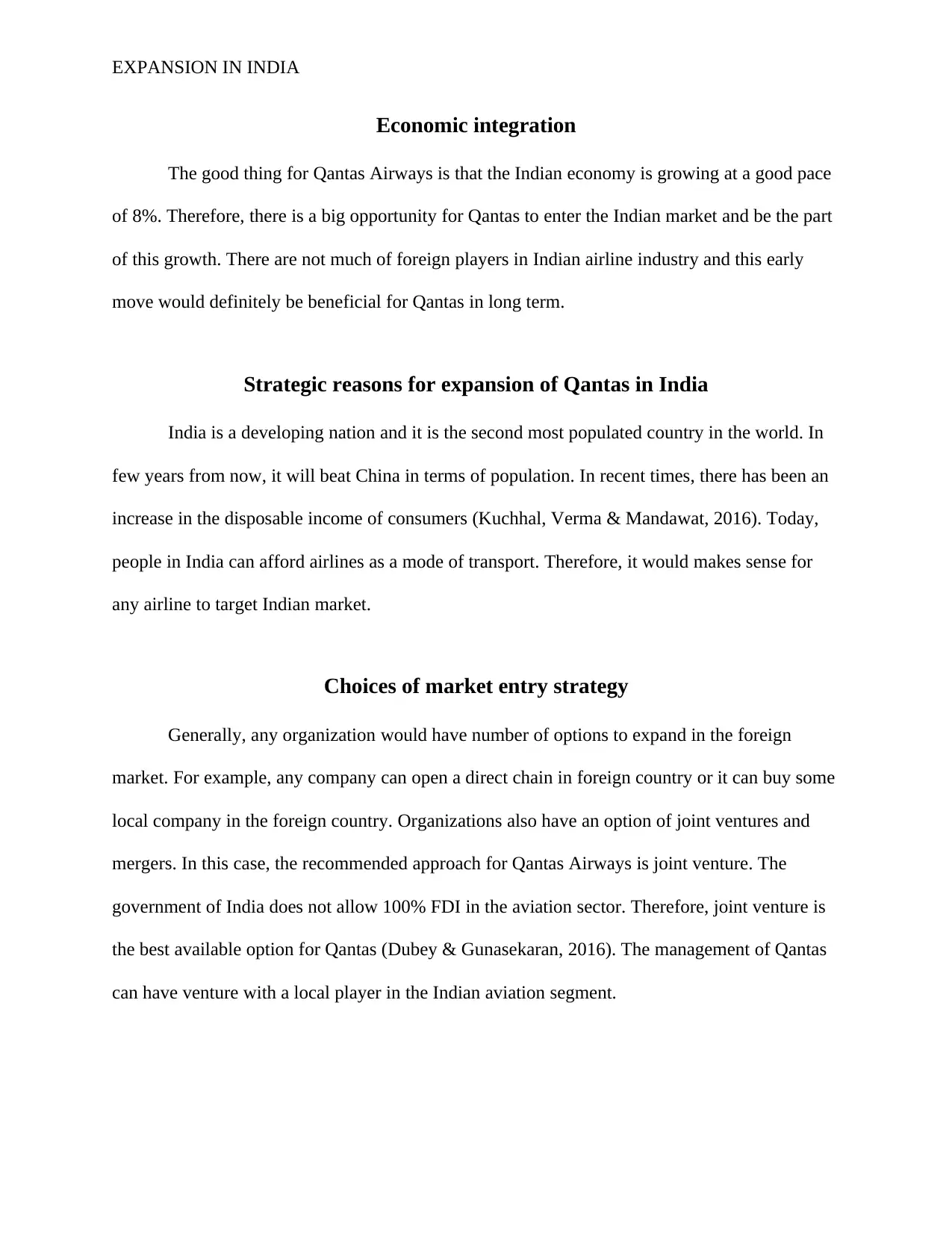
EXPANSION IN INDIA
Economic integration
The good thing for Qantas Airways is that the Indian economy is growing at a good pace
of 8%. Therefore, there is a big opportunity for Qantas to enter the Indian market and be the part
of this growth. There are not much of foreign players in Indian airline industry and this early
move would definitely be beneficial for Qantas in long term.
Strategic reasons for expansion of Qantas in India
India is a developing nation and it is the second most populated country in the world. In
few years from now, it will beat China in terms of population. In recent times, there has been an
increase in the disposable income of consumers (Kuchhal, Verma & Mandawat, 2016). Today,
people in India can afford airlines as a mode of transport. Therefore, it would makes sense for
any airline to target Indian market.
Choices of market entry strategy
Generally, any organization would have number of options to expand in the foreign
market. For example, any company can open a direct chain in foreign country or it can buy some
local company in the foreign country. Organizations also have an option of joint ventures and
mergers. In this case, the recommended approach for Qantas Airways is joint venture. The
government of India does not allow 100% FDI in the aviation sector. Therefore, joint venture is
the best available option for Qantas (Dubey & Gunasekaran, 2016). The management of Qantas
can have venture with a local player in the Indian aviation segment.
Economic integration
The good thing for Qantas Airways is that the Indian economy is growing at a good pace
of 8%. Therefore, there is a big opportunity for Qantas to enter the Indian market and be the part
of this growth. There are not much of foreign players in Indian airline industry and this early
move would definitely be beneficial for Qantas in long term.
Strategic reasons for expansion of Qantas in India
India is a developing nation and it is the second most populated country in the world. In
few years from now, it will beat China in terms of population. In recent times, there has been an
increase in the disposable income of consumers (Kuchhal, Verma & Mandawat, 2016). Today,
people in India can afford airlines as a mode of transport. Therefore, it would makes sense for
any airline to target Indian market.
Choices of market entry strategy
Generally, any organization would have number of options to expand in the foreign
market. For example, any company can open a direct chain in foreign country or it can buy some
local company in the foreign country. Organizations also have an option of joint ventures and
mergers. In this case, the recommended approach for Qantas Airways is joint venture. The
government of India does not allow 100% FDI in the aviation sector. Therefore, joint venture is
the best available option for Qantas (Dubey & Gunasekaran, 2016). The management of Qantas
can have venture with a local player in the Indian aviation segment.
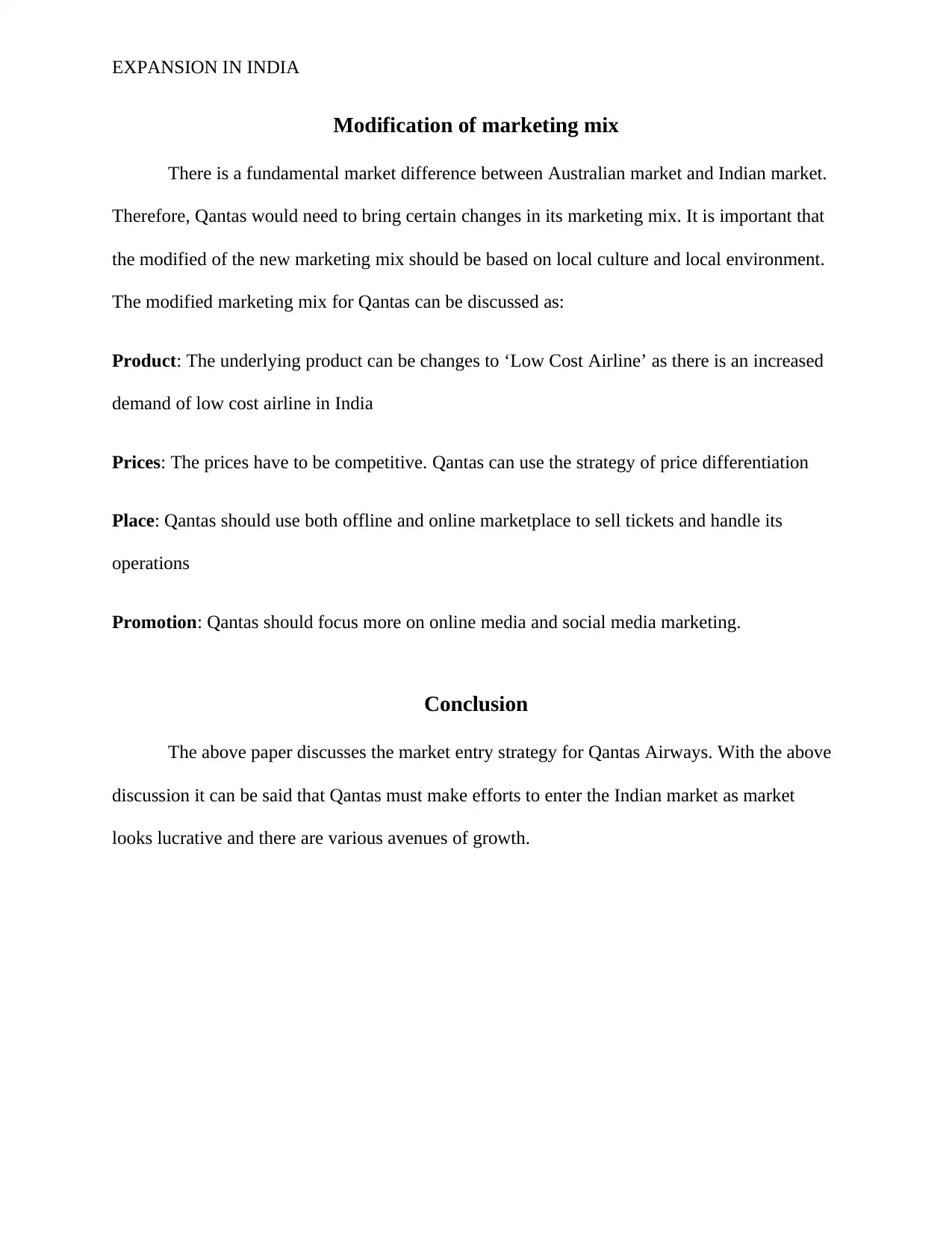
EXPANSION IN INDIA
Modification of marketing mix
There is a fundamental market difference between Australian market and Indian market.
Therefore, Qantas would need to bring certain changes in its marketing mix. It is important that
the modified of the new marketing mix should be based on local culture and local environment.
The modified marketing mix for Qantas can be discussed as:
Product: The underlying product can be changes to ‘Low Cost Airline’ as there is an increased
demand of low cost airline in India
Prices: The prices have to be competitive. Qantas can use the strategy of price differentiation
Place: Qantas should use both offline and online marketplace to sell tickets and handle its
operations
Promotion: Qantas should focus more on online media and social media marketing.
Conclusion
The above paper discusses the market entry strategy for Qantas Airways. With the above
discussion it can be said that Qantas must make efforts to enter the Indian market as market
looks lucrative and there are various avenues of growth.
Modification of marketing mix
There is a fundamental market difference between Australian market and Indian market.
Therefore, Qantas would need to bring certain changes in its marketing mix. It is important that
the modified of the new marketing mix should be based on local culture and local environment.
The modified marketing mix for Qantas can be discussed as:
Product: The underlying product can be changes to ‘Low Cost Airline’ as there is an increased
demand of low cost airline in India
Prices: The prices have to be competitive. Qantas can use the strategy of price differentiation
Place: Qantas should use both offline and online marketplace to sell tickets and handle its
operations
Promotion: Qantas should focus more on online media and social media marketing.
Conclusion
The above paper discusses the market entry strategy for Qantas Airways. With the above
discussion it can be said that Qantas must make efforts to enter the Indian market as market
looks lucrative and there are various avenues of growth.
⊘ This is a preview!⊘
Do you want full access?
Subscribe today to unlock all pages.

Trusted by 1+ million students worldwide
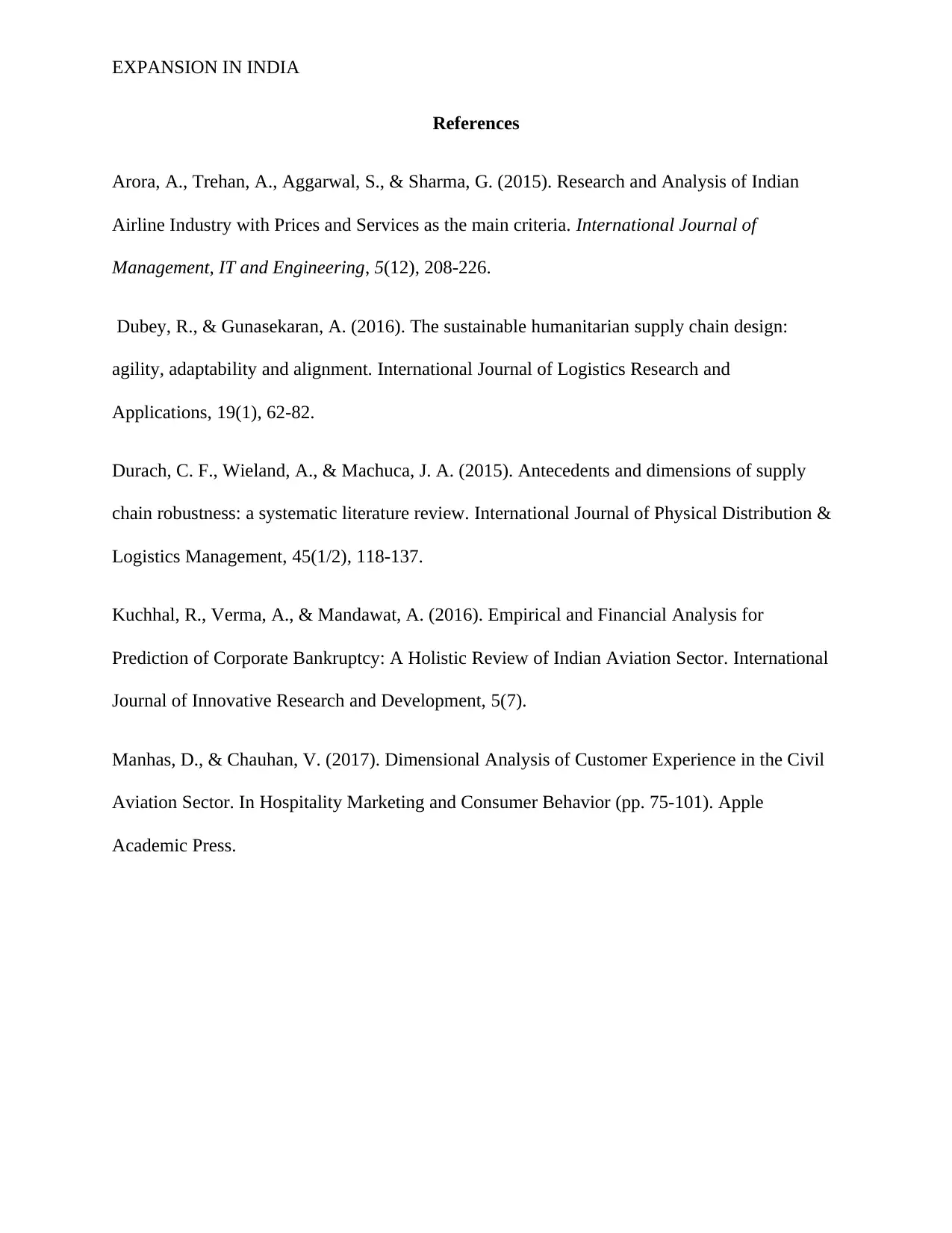
EXPANSION IN INDIA
References
Arora, A., Trehan, A., Aggarwal, S., & Sharma, G. (2015). Research and Analysis of Indian
Airline Industry with Prices and Services as the main criteria. International Journal of
Management, IT and Engineering, 5(12), 208-226.
Dubey, R., & Gunasekaran, A. (2016). The sustainable humanitarian supply chain design:
agility, adaptability and alignment. International Journal of Logistics Research and
Applications, 19(1), 62-82.
Durach, C. F., Wieland, A., & Machuca, J. A. (2015). Antecedents and dimensions of supply
chain robustness: a systematic literature review. International Journal of Physical Distribution &
Logistics Management, 45(1/2), 118-137.
Kuchhal, R., Verma, A., & Mandawat, A. (2016). Empirical and Financial Analysis for
Prediction of Corporate Bankruptcy: A Holistic Review of Indian Aviation Sector. International
Journal of Innovative Research and Development, 5(7).
Manhas, D., & Chauhan, V. (2017). Dimensional Analysis of Customer Experience in the Civil
Aviation Sector. In Hospitality Marketing and Consumer Behavior (pp. 75-101). Apple
Academic Press.
References
Arora, A., Trehan, A., Aggarwal, S., & Sharma, G. (2015). Research and Analysis of Indian
Airline Industry with Prices and Services as the main criteria. International Journal of
Management, IT and Engineering, 5(12), 208-226.
Dubey, R., & Gunasekaran, A. (2016). The sustainable humanitarian supply chain design:
agility, adaptability and alignment. International Journal of Logistics Research and
Applications, 19(1), 62-82.
Durach, C. F., Wieland, A., & Machuca, J. A. (2015). Antecedents and dimensions of supply
chain robustness: a systematic literature review. International Journal of Physical Distribution &
Logistics Management, 45(1/2), 118-137.
Kuchhal, R., Verma, A., & Mandawat, A. (2016). Empirical and Financial Analysis for
Prediction of Corporate Bankruptcy: A Holistic Review of Indian Aviation Sector. International
Journal of Innovative Research and Development, 5(7).
Manhas, D., & Chauhan, V. (2017). Dimensional Analysis of Customer Experience in the Civil
Aviation Sector. In Hospitality Marketing and Consumer Behavior (pp. 75-101). Apple
Academic Press.
1 out of 7
Related Documents
Your All-in-One AI-Powered Toolkit for Academic Success.
+13062052269
info@desklib.com
Available 24*7 on WhatsApp / Email
![[object Object]](/_next/static/media/star-bottom.7253800d.svg)
Unlock your academic potential
Copyright © 2020–2025 A2Z Services. All Rights Reserved. Developed and managed by ZUCOL.





